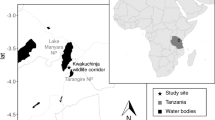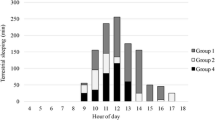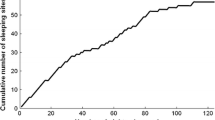Abstract
We collected data on sleeping site use of the François’ langur (Trachypithecus francoisi) between August 2003 and July 2004 at Nonggang Nature Reserve, China. We tested hypotheses regarding possible ultimate causes of sleeping site selection in light of our results. Langurs selected the ledges and caves on cliffs as sleeping sites. Of 23 identified sleeping sites, 7 were more frequently used than the others (≥9 times each, accounting for 64% of total observed nights). Langurs used most sleeping sites repeatedly, and reused some of them on consecutive nights; 4 consecutive nights were the longest run. We suggest that langurs choose sleeping sites to make approach and attack difficult by predators, and to increase familiarity so as to improve chances for escape. Langurs’ cryptic behaviors before entering sleeping sites and the rapid movement toward sleeping sites (4 min on average) with an increased level of vigilance may help to decrease the possibility of detection by predators. Access to food appears to have a profound influence on sleeping site selection in François’ langurs, as demonstrated by the langurs’ tendency to select sleeping sites close to their current main feeding sites. The position of sleeping site relative to the last feeding site of the day and the first feeding site of the subsequent morning indicated a strategy closer to that of a multiple central place forager than of a central place forager. Our results do not support the influences of other factors, e.g., avoidance of parasites, seeking comfort, and range or resource defense, on sleeping site selection.





Similar content being viewed by others
References
Altmann, J. (1974). Observational study of behavior: Sampling methods. Behaviour, 49, 227–262. doi:10.1163/156853974X00534.
Anderson, J. R. (1998). Sleep, sleeping sites, and sleep-related activities: Awakening to their significance. American Journal of Primatology, 46, 63–75. doi:10.1002/(SICI)1098-2345(1998)46:1<63::AID-AJP5>3.0.CO;2-T.
Caldecott, J. O. (1986). An ecological and behavioural study of the pig-tailed macaque. Conte,porary Primatology, 21, 1–259.
Chapman, C. A., Chapman, L. J., & Mclaughlin, R. L. (1989). Multiple central place foraging by spider monkeys: Travel consequences of using many sleeping sites. Oecologia, 79, 506–511. doi:10.1007/BF00378668.
Cui, L. W., Quan, R. C., & Xiao, W. (2006). Sleeping sites of black-and-white snub-nosed monkeys (Rhinopithecus bieti) at Baima Snow Mountain, China. Journal of Zoology, 270, 192–198.
Day, R. T., & Elwood, R. W. (1999). Sleeping site selection by the golden-handed tamarin Saguinus midas midas: The role of predation risk, proximity to feeding sites, and territorial defense. Ethology, 105, 1035–1051. doi:10.1046/j.1439–0310.1999.10512492.x.
Deng, Z. Q. (1988). Report on the investigation of karst geology from Longgang Natural Reserve. Guihaia, 1(Supplement), 1–16. in Chinese.
Di Bitetti, M. S., Vidal, E. M. L., Baldovino, M. C., & Benesovsky, V. (2000). Sleeping site preference in tufted capuchin monkeys (Cebus apella nigritus). American Journal of Primatology, 50, 257–274. doi:10.1002/(SICI)1098–2345(200004)50:4<257::AID-AJP3>3.0.CO;2-J.
Franklin, S. P. (2004). Predator influence on golden lion tamarin nest choice and presleep behavior. M.Sc. thesis, University of Maryland.
Grueter, C. C., & Ding, W. (2006). An observation of François’ langurs using caves at Mayanghe National Nature Reserve, Guizhou, China. Zoological Research, 27, 558–560.
Hamilton, W. J. (1982). Baboon sleeping site preferences and relationships to primate grouping patterns. American Journal of Primatology, 3, 41–53. doi:10.1002/ajp.1350030104.
Hausfater, G., & Meade, B. J. (1982). Alternation of sleeping groves by yellow baboons (Pipio cynocephalus) as a strategy for parasite avoidance. Primates, 23, 287–297. doi:10.1007/BF02381167.
Heymann, E. W. (1995). Sleeping habits of tamarins, Saguinus mystax and Saguinus fuscicollis (Mammalia; Primates; Callitrichidae), in north-eastern Peru. Journal of Zoology, 237, 211–226.
Huang, C. M. (2002). The white-headed langur in China. Guilin: Guangxi Normal University Press. (in Chinese).
Huang, J. T., Huang, L. B., & Guo, Y. R. (1983). Ecology of François’ langurs. Chinese Wildlife, 4, 11–12. in Chinese.
Huang, C. M., Wei, F. W., Li, M., Li, Y. B., & Sun, R. Y. (2003). Sleeping cave selection, activity pattern and time budget of the white-headed langur. International Journal of Primatology, 24(4), 825–846. doi:10.1023/A:1024628822271.
Huang, C. M., Li, Y. B., Zhou, Q. H., & Wei, F. W. (2004). A study on the behavior of cave-entering and leaving and selection of sleeping sites of a Francois’ langur group (Trachypithecus francoisi). In N. Tilo, S. Ulrike, & T. L. Ha (Eds.), Conservation of primates in Vietnam (pp. 137–143). Vietnam: Haki Publishing.
Kowalewski, M., & Zunino, G. E. (2005). The parasite behavior hypothesis and the use of sleeping sites by black howler monkeys (Alouatta caraya) in a discontinuous forest. Neotropical Primates, 13, 22–26. doi:10.1896/1413–4705.13.1.22.
Li, Z. Y. (2000). The socioecology of white-headed langurs, Presbytis leucocephalus, and its implications for their conservation. Ph.D. thesis, The University of Edinburgh.
Liu, Z. H., & Zhao, Q. K. (2004). Sleeping sites of Rhinopithecus bieti at Mt. Fuhe, Yunnan. Primates, 45, 241–248. doi:10.1007/s10329–004–0091-y.
Rabinowitz, A., Andau, P., & Chai, P. (1987). The clouded leopard in Malaysia. Oryx, 21, 107–111.
Ramirez, M. M. (1989). Ecology and demography of the moustached tamarin, Saguinus mystax, in northeastern Peru. Ph.D. thesis, City University of New York.
Reichard, U. (1998). Sleeping site, sleeping places, and presleep behavior of gibbons (Hylobates lar). American Journal of Primatology, 46, 35–62. doi:10.1002/(SICI)1098–2345(1998)46:1<35::AID-AJP4>3.0.CO;2-W.
Shu, Z. M., Zhao, T. L., & Huang, Q. C. (1988). Vegetation survey in Nonggang Nature Reserve. Guihaia, 1(Supplement), 185–214. in Chinese.
Sigg, H., & Stolba, A. (1981). Home range and daily march in a Hamadrya baboon troop. Folia Primatologica, 36, 40–75. doi:10.1159/000156008.
Smith, A. C., Knogge, C., Huck, M., Löttker, P., Buchanan-Smith, H. M., & Heymann, E. W. (2007). Long-term patterns of sleeping site use in wild Saddleback (Saguinus fuscicollis) and Mustached tamarins (S. mystax): Effects of foraging, thermoregulation, predation, and resource defense constraints. American Journal of Physical Anthropology, 134, 340–353. doi:10.1002/ajpa.20676.
Struhsaker, T. T. (1967). Ecology of vervet monkeys (Cercopithecus aethiops) in the Masai-Amboseli Game Reserve, Kenya. Ecology, 48, 891–904. doi:10.2307/1934531.
von Hippel, F. A. (1998). Use of sleeping trees by black and white colobus monkeys (Colobus guereza) in the Kekamega forest, Kenya. American Journal of Primatology, 45, 281–290. doi:10.1002/(SICI)1098–2345(1998)45:3<281::AID-AJP4>3.0.CO;2-S.
Wu, M. C., Wei, Z. Y., & He, N. L. (1987). Distribution and ecology of the François’ langur in Guangxi. Chinese Wildlife, 4, 12–13, 19.
Zhang, S. Y. (1995). Sleeping habits of brown capuchin monkeys (Cebus apella) in French Guiana. American Journal of Primatology, 36, 327–335. doi:10.1002/ajp.1350360407.
Zhou, Q. H., Wei, F. W., Li, M., Huang, C. M., & Luo, B. (2006). Diet and food choice of the François’ langur (Trachypithecus francoisi) in the Nonggang Nature Reserve, China. International Journal of Primatology, 27, 1441–1460. doi:10.1007/s10764-006-9082-8.
Zhou, Q. H., Huang, C. M., Li, Y. B., & Cai, X. W. (2007). Ranging behavior of the François’ langur (Trachypithecus francoisi) in the Fusui Nature Reserve, China. Primates, 48, 320–323. doi:10.1007/s10329–006–0027–9.
Acknowledgments
This project was financially supported by CAS Innovative Research International Partnership Project (CXTDS2005–4), CAS 100 Talent Programme, National Nature Science Foundation of China (No, 30830020, 30560023, 30860050), the Ecology PhD Construction Fund of Guangxi (XKY2006ZD01), and Project of Creative Team from Colleges and Universities in Guangxi. We thank H-S. Huang, S-Y. Liu, X. Wang, and J-Y. Bai for assistance in the field. The Guangxi Forestry Bureau and Nonggang Nature Reserve Administration Bureau provided enormous assistance for this project. We thank Mr. Cyril C. Grüter for language editing of this paper.
Author information
Authors and Affiliations
Corresponding author
Rights and permissions
About this article
Cite this article
Qihai, Z., Chengming, H., Ming, L. et al. Sleeping Site Use by Trachypithecus francoisi at Nonggang Nature Reserve, China. Int J Primatol 30, 353–365 (2009). https://doi.org/10.1007/s10764-009-9348-z
Received:
Accepted:
Published:
Issue Date:
DOI: https://doi.org/10.1007/s10764-009-9348-z




